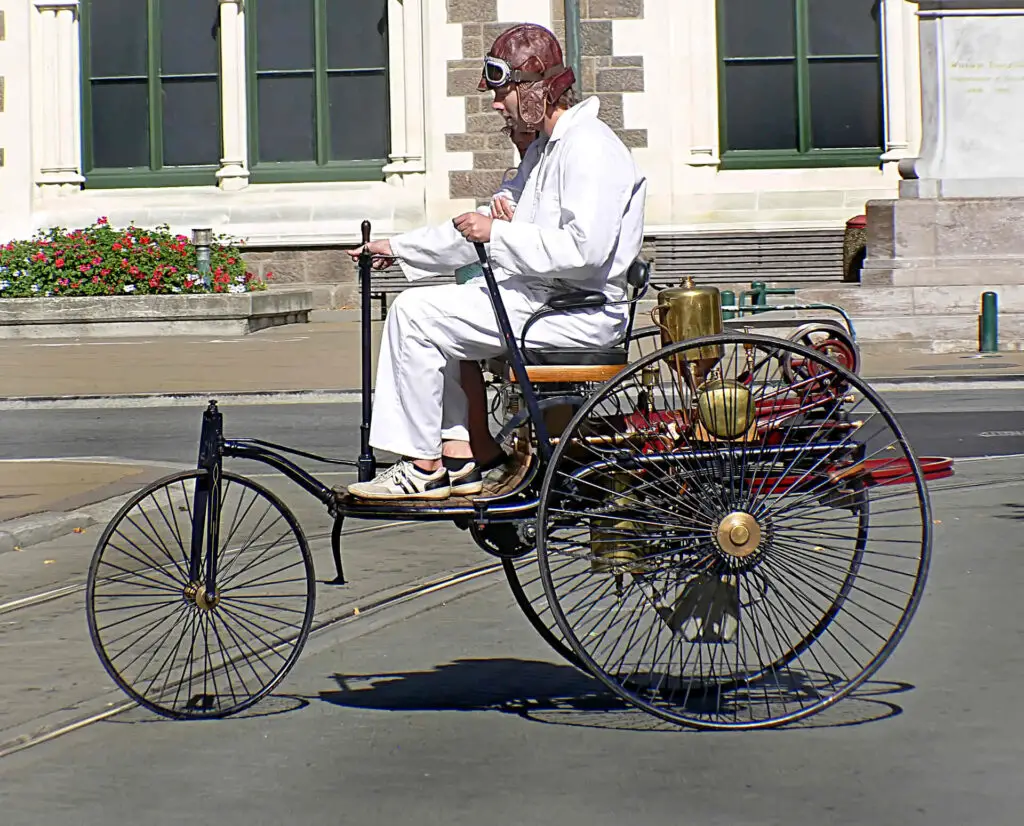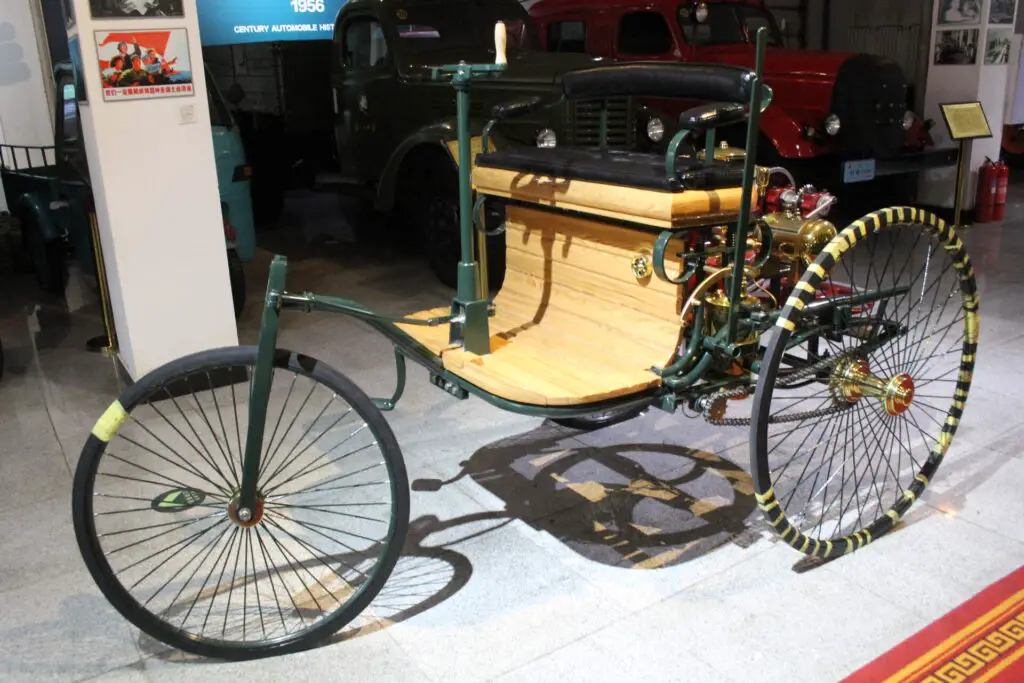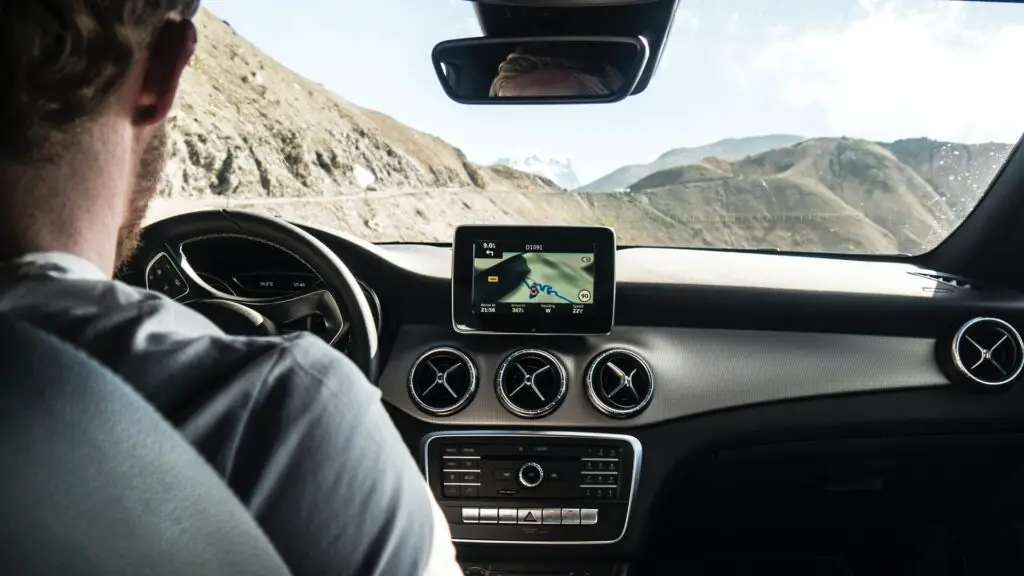So, who is the inventor of the first car ever made? There were numerous people who contributed to the creation of automobiles, from steam-powered vehicles invented by Ferdinand Verbiest to Dr. J. W. Carhart, who was the creator of a carriage that was driven on the USA wagon roads. Etienne Lenoir developed the first successful internal combustion engine in 1860. And so on.
Still, the person who was given the patent for the first car with a gasoline-powered engine was German engineer Karl Benz. He is credited with making the first car that paved the way for modern vehicles.
How Was the First Car Ever Made Created?
Karl Benz received the patent for the first car that had an engine that ran on gasoline in 1886. However, this happened after he worked non-stop in his workshop. He was even on the verge of giving up, but Bertha, his wife, and herself an inventor, decided to take their soon-to-be groundbreaking invention for a road test.
After the test, Benz added a two-speed transmission and brake upgrades. It took a couple of years of hard work and testing of a two-stroke engine that would make the essence of the Patent Motorcar. The components finally started working together, and 25 Motorwagens (railcars) were produced from 1886 to 1893. As of 2023, approximately 93.5 million vehicles were produced worldwide.

What Were the Components of the First Car Ever Made?
When Karl Benz invented his vehicle, he called it – the Patent Motorcar. It has numerous components that work together so that the vehicle runs smoothly. Here are more details about the design of his invention.
Gasoline Tank
The gasoline tank is located behind the seat and between the wheels. An interesting fact is that the only place where you could buy gasoline in Germany at that time was the pharmacy. It was sold as a stain remover.
Battery
Benz wanted to make the vehicle as safe as possible. Therefore, he created a box where the car battery would be placed behind the right wheel. This was very new back then. So, when it came to igniting the gasoline oxygen fumes with an electric spark, it was much safer than if you’d do it with a lighter.
Cylinder With a Piston
Perhaps the most important part of the Motorwagen was the cylinder with a piston. The piston moves front and back when the car is running. The engine is also a single-cylinder.
Drive Belt
The drive belt has two functions. It’s instrumental while driving, but it is also a brake. It’s made out of leather, so people who needed to brake a lot would often get problems with the leather band because it could wear out.
Flywheel
The flywheel at the rear end of the vehicle was needed for ignition. Once it started, the Motorwagen made humming noises and it could be driven with the help of a handle and brake in the front of the passenger seat.
What Made Motorwagen Exceptional for the 19th Century?
There were many electricity and steam-powered vehicles invented before the Patent Motorcar. Still, their technology wasn’t viable enough to spark the mass production of cars. Karl Benz actually came up with the internal combustion engine as well as the first car that was commercially available. The real feat was the single-cylinder four-stroke iron block head engine.
The engine’s output was two-thirds of 400 rpm horsepower. The top speed of a Motorwagen was about 10 miles an hour. To put it into perspective, today’s Bugatti is 1,000 times faster than the first car ever made.
How Did You Crank Up the Engine?
We don’t think too much about how we will start the car today. It’s simple – you only have to turn the key. The newest models don’t even need that, all can be done with a simple press of a button. But, for Motorwagen, this was not the case. You were required to spin the flywheel. The ignition had to be activated with the help of a switch located under the seat, and then the flywheel turned. When a gear lever was pulled back, the vehicle was propelled and could be driven on the streets.

How Did Driving Work on a Motorwagen?
It’s interesting that Benz thought that a three-wheel vehicle would work better than a four-wheeler, which was already a common thing in the 19th century. He decided that his vehicle would deliver power to the wheels in the rear end, and only one wheel in the front would be designed so that you could steer.
This two-seater had a wheelbase of 62 inches and a straightforward drive system that sent power to the rear axle via two chain drives connected by a beam axle. There is only one speed that is controlled by the leather strap. Back then, there weren’t different tires for winter and summer, while the person driving had a steering wheel that was a tiller and not a wheel.

The Role of Bertha Benz
Mrs. Benz wasn’t just a test driver. She was a notable inventor who added a couple of improvements to the design of the car. According to historical documents, she wanted to make the Motorwagen suitable for real-world conditions so that people could drive at night or day. Bertha Benz had the courage and ambition that Karl lacked since he was apprehensive about showing the invention to the world.
She demonstrated her perseverance by taking the Motorwagen for a 12-hour drive. She is credited with the first long-distance drive. Even though the vehicle broke down many times during the drive, she found a way to fix it each time.

How Has the Motorwagen Reshaped Our Understanding of Automobiles?
In the end, there were only 25 Motowagens produced, and the vehicle was short-lived. Still, it paved the way for numerous improvements that would be added to the established foundation. Without the prototype, there wouldn’t be any successful successors such as the Benz Velo. The three-wheel system would soon be surpassed since the inventor would figure out how a system with four wheels could work properly.
The Technology of the Engine Is What Stood the Test of Time
Even though the Motor Wagons’ engines produced low outputs, the design actually involved components that are crucial parts of contemporary internal combustion engines. The necessary components entail a carburetor that is exhaust-heated and float-controlled, exhaust-valve actuation, and an ignition system that features a coil, battery, and a spark plug.

Pre and Post-Motorwagen Inventions – Who Contributed to the History of the First Car?
Even though Karl Benz is credited for the invention of the first proper car as a foundation for all future cars to come, there were many inventors who tried to come up with a vehicle that would replace the use of animals. Other figures played a part in the creation of the car even before Motorwagen was perfected. Here is a table with people who should be recognized for their work.
| Name | Invention | Date |
| Nicolas-Joseph Cugnot | Self-propelled steam military vehicle | 1769 |
| Robert Anderson | Electric carriage | 1832-1839 |
| Wilhelm Maybach and Gottlieb Wilhelm Daimler | Four-wheeler with a four-stroke engine that ran on gasoline | 1886 |
| George Baldwin Selden | Carriage that had internal combustion engine on gasoline | 1876/95 |
| Charles Duryea and Frank Duryea | A car that was powered by gas | 1893 |
After Motorwagen, Innovations Brought About New Types of Cars
The era after Patent Motorwagens saw numerous improvements and cars with additional features kept arriving. Let’s delve into what other types of vehicles people got to drive.
The First Inexpensive Car – How Ford’s Model Ts Were Made?
Cars were off-limits for regular people. First, they were thought of as an item that was in possession of the wealthy. There was no vehicle that was for the people because the prices were so high. But Henry Ford decided to change this situation, and in 1908 he came up with the Ford Model T. Suddenly, cars were affordable. It was produced with the help of an assembly line which made it possible for Ford to sell it at such a low price.
Model Ts could be seen everywhere because the company managed to decrease the price to only $260. In today’s money, this amount equals $4,200. The factory also implemented some novelties, such as a minimum wage and 8-hour shifts for its employees.
Constant Innovations Resulted In People Having the Option to Buy First Cars With Seatbelt
A doctor called C. H. Sheldon was the first one who came up with the idea of a seat belt. However, this idea was met with dissatisfaction from the buyers. However, retractable three-point seat belts became a thing when the designer Nils Bohlin created them in 1958. The first car with this kind of seatbelt was the Volvo PV544.
The Greatest Upgrade Is Thought to Be the AC – Here’s What Model Initially Got One
Not long after the Model T, air-conditioning was installed in cars by the factory. The model that featured this addition was the Packard from 1940. Thirty years later, almost all new cars had air conditioning. It might be surprising to find out that some models had affixed window decals to sell more automobiles that had ACs.
Safety Was Improved With the Addition of Airbags
Airbags were implemented in the design of cars recently. They are necessary to decrease the risk of death or injuries during accidents. All modern cars have airbags, but in the past, this was not the case. The very first four-wheeler that included airbags was the Chevrolet Impala from 1973. After this, airbags started to be offered as options for models such as Cadillac, Oldsmobile, and Buick. All cars had airbags as a feature from 1987.
Advanced Technology Was the Next Addition – Here’s What Car Had Navigation System First
A navigation system does not mean GPS tracking. The very first navigation system didn’t rely on satellites to locate the vehicle. It was actually a system referred to as Electro Gyrocator that determined whether the vehicle was moving. It featured various maps on its display. Honda developed Electro Gyrocator, and it was added to its models in 1981. This navigation system, however, proved to be unsuccessful. The first four-wheeler with GPS tracking was the Toyota Soarer from 1986.

Thanks to Karl Benz, There Will Be Many More Innovations in the Automotive Industry
The first car ever made looks nothing like the modern cars of today. However, Karl Benz’s Motorwagen shaped the technology that was used for the development of all models that came after. The design was perfected throughout the 20th century so that people can now drive electric and hybrid vehicles that are used, new, or specifically designed for off-road driving.
They also have numerous features, such as parking assist, reverse assist, and voice and gesture controls. But it all started with a three-wheeler that had to be started by spinning a flywheel at the rear. The entire history of cars is nothing short of remarkable.








